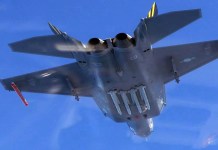Whiteman Air Force Base, Missouri, is officially set to become the second operating base for the US Air Force’s cutting-edge B-21 Raider, which is slated to replace the B-2 Spirit stealth bomber.
The announcement was made on September 11, 2024, by Congressman Mark Alford (MO-04), a member of the House Armed Services Committee, and Senator Eric Schmitt.
“We’re so proud to hear that Secretary Kendall has approved Whiteman as the second location for the B-21 stealth bomber,” said Congressman Alford. “This is huge news for Missouri’s Fourth District and all the patriotic men and women serving at Whiteman.”
Whiteman’s selection as the second operating base follows a rigorous process. In 2019, the Air Force concluded its Strategic Basing Process, identifying Ellsworth Air Force Base, South Dakota; Whiteman Air Force Base, Missouri; and Dyess Air Force Base, Texas, as the preferred locations for B-21 operations.
Following an Environmental Impact Statement and regulatory reviews, Ellsworth was officially named the first base for the new bomber in 2021. It will become home to both the B-21 main operating base and the Formal Training Unit.
We are so proud to hear that, after lots of hard work, @SecAFOfficial has approved Whiteman Air Force Base as the second location for the B-21 Stealth Bomber.
The B-21 will be the backbone of our bomber force, and we’re proud to champion the effort to bring it to Whiteman.
This… pic.twitter.com/iyZoor3Z9q
— Rep. Mark Alford (@RepMarkAlford) September 11, 2024
Ellsworth was chosen as the first operating base due to its ample space and existing infrastructure, which allows it to support simultaneous missions with minimal additional cost and environmental impact.
In August, EurAsian Times reported that Ellsworth was undergoing a major runway renovation to accommodate the new B-21 Raider stealth bomber.
With the recent announcement, Whiteman Air Force Base is now positioned to become the second operational base for the B-21 Raider.
Senator Eric Schmitt expressed his enthusiasm about the development, emphasizing Whiteman’s significance to the US nuclear triad and national security.
“Whiteman Air Force base is a critical aspect of the United States’ nuclear triad and a vital piece to our nuclear deterrence,” Senator Schmitt remarked.
Schmitt added, “I am not only proud to represent Whiteman’s interests here in the Senate but equally proud of the rich military history and culture the State of Missouri boasts as a whole. The Air Force’s decision to select Whiteman Air Force Base as the second operating base for the B-21 Raider ensures that Whiteman will continue its important work maintaining, flying, and training on the stealth bomber.”
Senator Schmitt has been actively involved in advocating for Whiteman’s selection as the second B-21 base. In August 2023, he visited Whiteman to explore how he could leverage his position on the Senate Armed Services Committee to strengthen the base’s candidacy as the second Main Operating Base (MOB 2) for the advanced stealth bomber.
B-21 Raider
The B-21 Raider is poised to succeed the aging B-2 Spirit bombers and symbolize the future of the US Air Force’s long-range strike capabilities.
As a sixth-generation bomber, the B-21 integrates cutting-edge stealth technology, sophisticated electronics, and the versatility to carry both conventional and nuclear munitions.
Northrop Grumman unveiled the B-21 Raider in early December 2022, marking the first new strategic bomber introduction in a generation since the B-2 Spirit’s debut in November 1988.
While the Raider bears a resemblance to the B-2, it represents a major advancement in aircraft technology and development. The B-21 is designed to be the cornerstone of the future bomber fleet, gradually replacing the aging Rockwell B-1 Lancer and B-2 Spirit.
The B-21 Raider, named after the 80 airmen who participated in the historic World War II “Doolittle Raid” in Tokyo in 1942, was developed using Northrop Grumman’s advanced digital engineering and manufacturing techniques.

The bomber made its first test flight in Palmdale, California, in November 2023 and continues to undergo rigorous testing.
The aircraft has commenced flight testing at Edwards Air Force Base, California, and is advancing towards becoming a central element of the Air Force’s bomber fleet.
In May 2024, the US military released images of the B-21 Raider in flight, showcasing its progress as it nears its role as the nation’s next-generation nuclear stealth bomber.
The US Air Force currently plans to acquire over 100 B-21s. However, Global Strike Command and various defense experts have suggested the need for 225 to 250 B-21s.
However, the Air Force has indicated that its decision to limit the B-21 procurement to 100 units reflects a cautious approach, anticipating potential advancements that could lead to even more advanced aircraft in the future.
According to US officials, the full production run of 100 B-21 bombers is not expected to be completed until the mid-to-late 2030s. This timeline indicates that the bomber will not be produced at a rapid pace, with an anticipated annual output of fewer than 10 airframes.
Pentagon acquisition and sustainment chief William LaPlante earlier noted that the B-21’s production rate was intentionally kept low to safeguard it from potential budget cuts. The USAF has not disclosed any details of Northrop’s B-21 production contract due to classification.
- Contact the author at ashishmichel(at)gmail.com
- Follow EurAsian Times on Google News




